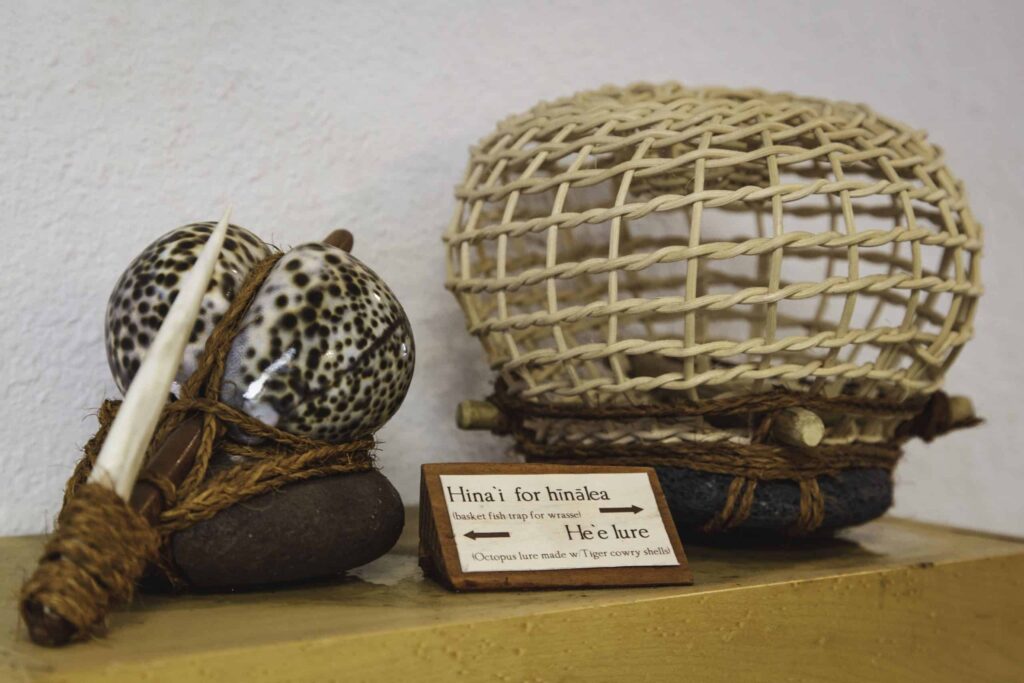At Maui Ocean Center we take pride in our commitment to immersing ourselves in the culturally rich history of Hawai‘i’. Our deep respect for the traditions and heritage of the island is what drives us to create meaningful and authentic experiences for our visitors. From our exhibits showcasing native marine species to our educational programs highlighting the profound connection between the ocean and Hawaiian culture, we strive to honor and celebrate the unique heritage of this beautiful place. With every exhibit, we aim to foster a greater understanding and appreciation for Hawaiian history that continues to inspire and guide us.
So come and listen to the stories of the kanaka maoli, Hawai‘i’s first people. Hear how they sailed across the Pacific in double-hulled canoes using the stars as guides. Submerse yourself in their history, culture, and unique traditions — marvel at their profound relationship with the land (mauka) and the sea (makai). Learn to say a few words in ‘ōlelo Hawai‘i, the living language of this place.
It’s believed that the Hawaiin islands were uninhabited until around 400 – 500 AD. Incredibly skilled mariners, Polynesians had a long history of exploration and settlement of other lands. The reasons for this aren’t firmly understood, but it’s likely that groups left for new shores when islands became overpopulated. Less powerful groups may have also fled to new horizons to avoid war with other tribal groups.
Polynesians first landed on the island of the big island of Hawai‘i’, at Ka Le on the southern coast. Over the years, they spread out to other islands where they were the sole inhabitants for several hundreds of years, until the Tahitians landed around 1000 A.D.

The Polynesians traveled over 2,000 miles in a double-hulled canoe called a “Wa’a”. They were known to be voyagers and keen observers of ‘natural phenomenons’, such as the stars, migratory birds, ocean currents, rainbows and whales, all of which helped guide them to the Hawaiian Islands.
These early voyagers were not alone. They also brought along many animals and plants to help sustain them at their new homes.
Our Hawaiians and the Sea Exhibit is dedicated to the rich culture of the first Hawaiians on the Islands. We try to have our guests experience what it’s like to take a step into the past.
Discover captivating artifacts, traditional tools, and intricate artwork that showcase the profound relationship between Hawaiians and the sea. Gain a deeper understanding of their sustainable fishing practices, navigation techniques, and legends surrounding marine life.
Learn about the Kaho’olawe Island, also known as the “Target Isle,” a small, uninhabited island located in the Hawaiian archipelago. Traditionally, the island served as a place of spiritual retreat, and it held a vital role in navigation and celestial observations for Hawaiian voyagers. Kahoʻolawe is associated with the Hawaiian god of creation, Kanaloa, and its sacredness is deeply intertwined with Hawaiian cosmology.
In modern history however, Kahoʻolawe was used as a military training ground by the United States during World War II. The island suffered extensive environmental damage due to bombing exercises and military activities, which led to protests and a heightened awareness of the need for preservation and cultural restoration.
In 1994, the island was returned to the state of Hawaiʻi, and efforts to restore and protect its cultural and natural resources began. Today, Kahoʻolawe is managed by the Kahoʻolawe Island Reserve Commission (KIRC), which focuses on ecological restoration, cultural preservation, and education.
This enlightening exhibit at Maui Ocean Center is a must-visit for those seeking to explore the unique maritime heritage of Hawaii.
Immerse Yourself in our SEA-News featuring Hawaiʻi’s marine life, inspirational conservation, and glimpses behind-the-scenes.

